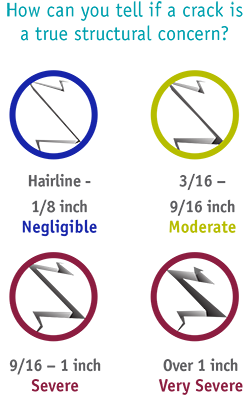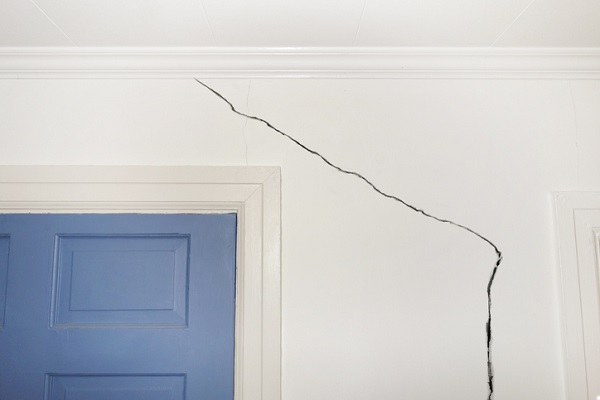From D.A.R.E. to houses and buildings, we’re often trained to look at all cracks as bad. They can be unsightly in homes and buildings, but are they always an indication of serious structural distress or possibly unsafe conditions? While some kinds are always bad, certain cracks in homes and buildings are much less serious than others. Today, we’ll walk through some misconceptions about the common crack, explain what causes them, and show you the kinds of cracks you should truly be worried about.
How cracks usually form
According to Walt Keaveny—Risk Manager and Principal Engineer with 2-10 Home Buyers Warranty (2-10 HBW)—cracks appear in brittle materials such as concrete, sheetrock, tile, wood, stone, brick, and stucco. Structural distress can cause cracks, but most cracks have little to no effects on a home’s structure.
Expansion and contraction of building materials are the most common causes of cracks. Changes in moisture content and temperature have some of the biggest effects. Expansion and contraction cracks do not represent a structural concern.
Concrete, mortar, grout, and stucco can shrink and crack for months after construction as they slowly dry and lose moisture. Shrinkage cracks in concrete floor slabs are very common, and you shouldn’t worry too much about them, since they don’t compromise structural integrity.
Likewise, wood framing, wood floors, and trim can also shrink as the wood dries and becomes acclimated to lower inside humidity. Temperature changes cause construction materials to expand and contract daily and seasonally.
For example, the temperature difference between the exterior and interior sides of a wall can cause as much as 1/2 inch of bowing stress daily. Additionally, the temperature in an attic can fluctuate daily, by as much as 100°F.
Due to these fluctuations, you can safely expect cracking. It’s why builders use construction joints in materials such as concrete, brick, stucco, and tile. The joints allow for stress relief in the form of controlled cracking along a pre-determined alignment. Cracks often come from doors and windows, since these wall openings act as large construction joints to relieve stresses.
What about foundational cracks?
It’s important to note that all foundations on soil move to some degree. Soils that support the foundation may consolidate and settle due to the weight of the house. They may also shrink and swell due to soil moisture fluctuations, or heave due to frost activity.
In new homes and buildings, it takes time for soils to adjust to new foundations and landscape irrigation. This is why builders prefer to wait until the end of the typical one-year workmanship warranty period to make any repairs—to do so early may require more, avoidable repairs.
Most foundations are designed for up to one inch of soil movement. However, in highly expansive soil areas, builders may design slab foundations for up to four inches of soil movement. When the foundation moves, the entire structure moves with it, causing some degree of racking, distortion, and cracking. As you design foundations, make sure the foundation can maintain structural integrity as it moves. But some cracking is inevitable.
In short, most cracks are simply cosmetic and are a part of a homeowner’s routine, long-term maintenance. But how can you tell if it’s a true structural concern?
How to determine whether you have a crack problem
According to R.W. Day’s Forensic Geotechnical and Foundation Engineering, here are guidelines regarding the severity of cracks. It’s important to note that cracks alone are not necessarily indicative of a structural concern.

They’re more likely to be a structural concern if accompanied by other indications of structural distress, such as inoperable doors and windows, or excessively sloping floors and surfaces.
Cracks with significant vertical displacement across the face of the crack may indicate a structural concern.
Cracks in basement walls, especially horizontal cracks, accompanied by bowing or leaning of the wall are cause for concern.
Conclusion: What to do if you’re unsure
If you’re not sure whether your crack is routine or a problem, retain the services of a qualified professional structural engineer licensed in your state. The engineer will make observations and take photos and measurements. They may conduct a floor elevation survey to evaluate structural deflection (i.e., bending) and tilt. The measurements and survey may be used as reference points, if needed, to compare with any future measurements and surveys.
The engineer may recommend remedial measures such as drainage improvements, landscape adjustments, rain gutters, foundation watering, or foundation repair. Keep in mind that the best time to make any cosmetic repairs is when foundation movement has ceased.
Finally, if you’ve covered your homes with a third-party structural warranty from 2-10 HBW, you’ll have access to qualified warranty administration personnel available to answer coverage questions. That can take much of the time and guesswork out of deciding the best course of action to address cracks.
Learn how you can protect your business and add valuable selling points to your new builds with a 2-10 HBW structural warranty.
Special thanks to Walt Keaveny, whose expertise inspired this article.
Related content
Why a Builders Warranty Matters to You and Your Buyers








